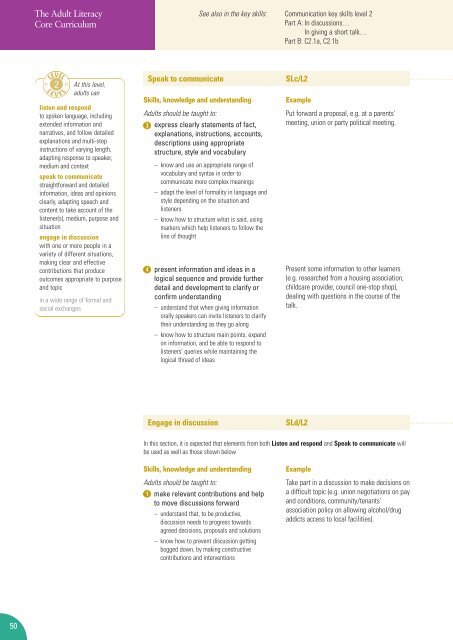Adult Literacy Core Curriculum - Nationally developed Skills for Life ...
Adult Literacy Core Curriculum - Nationally developed Skills for Life ...
Adult Literacy Core Curriculum - Nationally developed Skills for Life ...
Create successful ePaper yourself
Turn your PDF publications into a flip-book with our unique Google optimized e-Paper software.
50<br />
The <strong>Adult</strong> <strong>Literacy</strong><br />
<strong>Core</strong> <strong>Curriculum</strong><br />
At this level,<br />
adults can<br />
listen and respond<br />
to spoken language, including<br />
extended in<strong>for</strong>mation and<br />
narratives, and follow detailed<br />
explanations and multi-step<br />
instructions of varying length,<br />
adapting response to speaker,<br />
medium and context<br />
speak to communicate<br />
straight<strong>for</strong>ward and detailed<br />
in<strong>for</strong>mation, ideas and opinions<br />
clearly, adapting speech and<br />
content to take account of the<br />
listener(s), medium, purpose and<br />
situation<br />
engage in discussion<br />
with one or more people in a<br />
variety of different situations,<br />
making clear and effective<br />
contributions that produce<br />
outcomes appropriate to purpose<br />
and topic<br />
in a wide range of <strong>for</strong>mal and<br />
social exchanges<br />
Speak to communicate SLc/L2<br />
<strong>Skills</strong>, knowledge and understanding<br />
<strong>Adult</strong>s should be taught to:<br />
3 express clearly statements of fact,<br />
explanations, instructions, accounts,<br />
descriptions using appropriate<br />
structure, style and vocabulary<br />
4<br />
– know and use an appropriate range of<br />
vocabulary and syntax in order to<br />
communicate more complex meanings<br />
– adapt the level of <strong>for</strong>mality in language and<br />
style depending on the situation and<br />
listeners<br />
– know how to structure what is said, using<br />
markers which help listeners to follow the<br />
line of thought<br />
present in<strong>for</strong>mation and ideas in a<br />
logical sequence and provide further<br />
detail and development to clarify or<br />
confirm understanding<br />
– understand that when giving in<strong>for</strong>mation<br />
orally speakers can invite listeners to clarify<br />
their understanding as they go along<br />
– know how to structure main points, expand<br />
on in<strong>for</strong>mation, and be able to respond to<br />
listeners’ queries while maintaining the<br />
logical thread of ideas<br />
Example<br />
Engage in discussion SLd/L2<br />
<strong>Skills</strong>, knowledge and understanding<br />
See also in the key skills: Communication key skills level 2<br />
Part A: In discussions. . .<br />
In giving a short talk. . .<br />
Part B: C2.1a, C2.1b<br />
<strong>Adult</strong>s should be taught to:<br />
1 make relevant contributions and help<br />
to move discussions <strong>for</strong>ward<br />
– understand that, to be productive,<br />
discussion needs to progress towards<br />
agreed decisions, proposals and solutions<br />
– know how to prevent discussion getting<br />
bogged down, by making constructive<br />
contributions and interventions<br />
Put <strong>for</strong>ward a proposal, e.g. at a parents’<br />
meeting, union or party political meeting.<br />
Present some in<strong>for</strong>mation to other learners<br />
(e.g. researched from a housing association,<br />
childcare provider, council one-stop shop),<br />
dealing with questions in the course of the<br />
talk.<br />
In this section, it is expected that elements from both Listen and respond and Speak to communicate will<br />
be used as well as those shown below<br />
Example<br />
Take part in a discussion to make decisions on<br />
a difficult topic (e.g. union negotiations on pay<br />
and conditions, community/tenants’<br />
association policy on allowing alcohol/drug<br />
addicts access to local facilities).

















